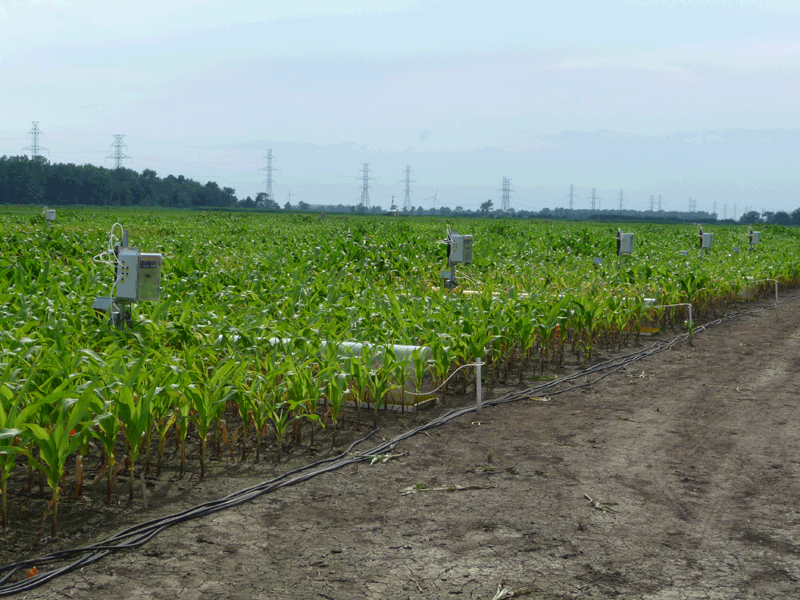Gone with the wind
INCREASING THE LONGEVITY OF APPLIED NITROGEN
A NEW AGRICULTURE and Agri-Food Canada (AAFC) study is trying to come up with the best combination of application methods and sources to keep nitrogen in the soil and available to crops for as long as possible.

Lead scientist Dr. Craig Drury is a soil biochemist with AAFC in Harrow, Ontario. Drury says between 1972 and 2010, fertilizer sales in Ontario increased 66 percent. He then points to a 2010 survey of fertilizer sales which says nitrogen fertilizers account for about 72 percent of all fertilizer sales in Canada.
“We know nitrogen is a key ingredient for good crop performance,” explains Drury. “But applied nitrogen is also very costly. So, this study is looking to discover the best combination of application methods and nitrogen sources to keep nitrogen in the soil for as long as possible; basically, how farmers can use expensive nitrogen more efficiently.”
HOW THE STUDY WORKS
The study, which started in summer 2013, is running for the next three years to account for the different seasons and environmental conditions being faced by producers in the Lower Great Lakes region, St. Lawrence lowlands, Lake Manitoba region, and intensive feedlot region of Southern Alberta. Corn was selected as the test crop because corn requires the most nitrogen and, therefore, has the potential for the greatest amount of nitrogen loss.
In one of the field trials, two different forms of applied nitrogen (urea granules and urea-ammonium nitrate), with and without nitrogen inhibitors, are being looked at and combined with three different application methods (broadcasting, injecting and streaming). The study is measuring how these combinations respond in terms of ammonia volatilization loss (i.e. the loss of nitrogen from the soil as an ammonia gas) and, ultimately, how much nitrogen is left in the soil to go to the crop and what those final crop yields will be.
The project is using advanced wind tunnel technology to measure the amount of ammonia volatilization. As Drury explains, ammonia may be coming off of the soil depending on several environmental factors such as temperature, soil pH, moisture levels and wind speed. The wind tunnel is the diagnostic tool that allows researchers to measure the amount of ammonia that is being lost.
The wind tunnel is constructed between the rows of corn using a metal frame measuring two metres long by 0.5 metres wide. Clear, acrylic plastic is attached to the frame to form the tunnel and enclose the soil (but not the plants.) At one end, outside of the tunnel where nothing is applied to the soil, is a tube-like acid trap which takes a sample of the air before it goes into the tunnel. At the other end is a fan which pulls the air into the wind tunnel at a constant velocity, mimicking typical wind speeds in the area. As the air passes over the soil and goes into the fan enclosure it passes through another tube-like acid trap that captures the outgoing air sample. By comparing the ammonia concentration of the incoming and outgoing air samples, researchers can accurately calculate the ammonia loss of the soil. Samples are collected every 24 hours and losses are measured over a 28 day period.
To account for soil variability, the study uses three different replicate plots with wind tunnels for each treatment being applied.
The wind tunnels are open at either end, so the enclosed soil temperature is similar to the temperature of the soil in the field. As for rainfall, because the tunnels enclose a good part of the soil, rainfall is measured and, the next day, the same amount of water is added to the soil using watering cans.
Since the study is still in its infancy, Drury says he only has preliminary findings this time and final recommendations will be made following two more field seasons. However, under the field conditions in this first year of the study, injecting nitrogen into the soil reduced volatilization losses by about 38 percent. Compared to broadcasting and applying inhibitors with the urea or UAN solution, losses were reduced by up to 64 percent.
In the future, Drury says there are a couple of different ways researchers can go after this initial study is complete: researchers may look at and refine the timing and rate of nitrogen application, or perhaps try a different crop.
“I really don’t have final recommendations yet for the optimal combination of application method and fertilizer sources,” says Drury. “It really depends on what we find over the next couple of years as to what we recommend and what our next logical step will be to reduce losses even further.”
For more information and updates on the study, visit AAFC online at http://www.agr.gc.ca. •







